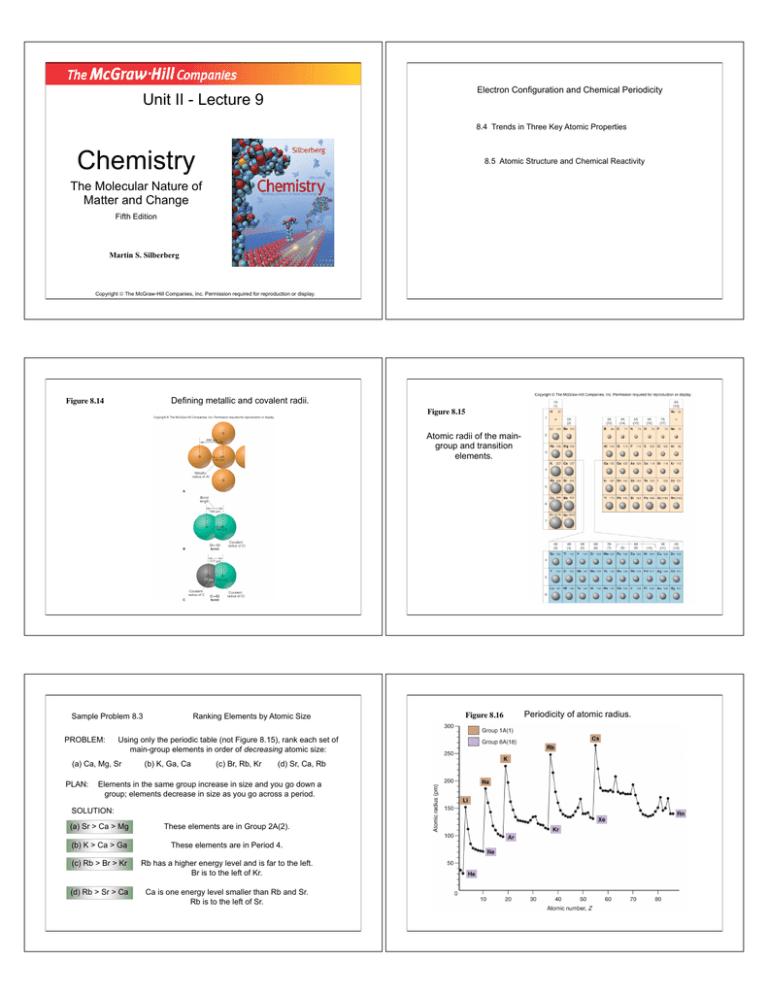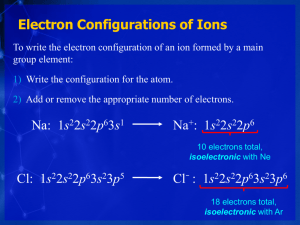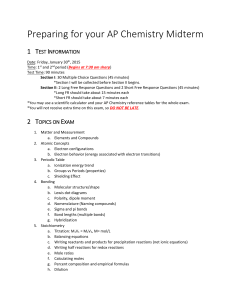Copyright The McGraw-Hill Companies, Inc. Permission required
advertisement

Electron Configuration and Chemical Periodicity Unit II - Lecture 9 8.4 Trends in Three Key Atomic Properties Chemistry 8.5 Atomic Structure and Chemical Reactivity The Molecular Nature of Matter and Change Fifth Edition Martin S. Silberberg Copyright ! The McGraw-Hill Companies, Inc. Permission required for reproduction or display. Defining metallic and covalent radii. Figure 8.14 Figure 8.15 Atomic radii of the maingroup and transition elements. Sample Problem 8.3 PROBLEM: Using only the periodic table (not Figure 8.15), rank each set of main-group elements in order of decreasing atomic size: (a) Ca, Mg, Sr PLAN: Ranking Elements by Atomic Size (b) K, Ga, Ca (c) Br, Rb, Kr (d) Sr, Ca, Rb Elements in the same group increase in size and you go down a group; elements decrease in size as you go across a period. SOLUTION: (a) Sr > Ca > Mg These elements are in Group 2A(2). (b) K > Ca > Ga These elements are in Period 4. (c) Rb > Br > Kr Rb has a higher energy level and is far to the left. Br is to the left of Kr. (d) Rb > Sr > Ca Ca is one energy level smaller than Rb and Sr. Rb is to the left of Sr. Figure 8.16 Periodicity of atomic radius. Figure 8.17 Figure 8.19 Periodicity of first ionization energy (IE1). The first three ionization energies of beryllium (in MJ/ mol). First ionization energies of the main-group elements. Figure 8.18 Sample Problem 8.4 PROBLEM: Using the periodic table only, rank the elements in each of the following sets in order of decreasing IE1: (a) Kr, He, Ar PLAN: Ranking Elements by First Ionization Energy (b) Sb, Te, Sn (c) K, Ca, Rb (d) I, Xe, Cs IE decreases as you proceed down in a group; IE increases as you go across a period. SOLUTION: (a) He > Ar > Kr Group 8A(18) - IE1 decreases down a group. (b) Te > Sb > Sn Period 5 elements – IE1 increases across a period. (c) Ca > K > Rb Ca is to the right of K; Rb is below K. (d) Xe > I > Cs I is to the left of Xe; Cs is farther to the left and down one period. Sample Problem 8.5 Identifying an Element from Successive Ionization Energies PROBLEM: Name the Period 3 element with the following ionization energies (in kJ/mol) and write its electron configuration: PLAN: IE1 IE2 1012 1903 IE3 IE4 2910 4956 IE5 6278 IE6 22,230 Look for a large increase in energy which indicates that all of the valence electrons have been removed. SOLUTION: The largest increase occurs after IE5, that is, after the 5th valence electron has been removed. Five electrons would mean that the valence configuration is 3s23p3 and the element must be phosphorous, P (Z = 15). The complete electron configuration is 1s22s22p63s23p3. Figure 8.20 Figure 8.21 Electron affinities of the main-group elements. Trends in three atomic properties. Figure 8.22 Figure 8.24 Trends in metallic behavior. The trend in acid-base behavior of element oxides. Figure 8.23 Figure 8.25 The change in metallic behavior of Group 5A(15) and Period 3. Main-group ions and the noble gas electron configurations. Sample Problem 8.6 PROBLEM: Writing Electron Configurations of Main-Group Ions The Period 4 crossover in sublevel energies. Figure 8.26 Using condensed electron configurations, write reactions for the formation of the common ions of the following elements: (a) Iodine (Z = 53) (b) Potassium (Z = 19) (c) Indium (Z = 49) PLAN: Ions of elements in Groups 1A(1), 2A(2), 6A(16), and 7A(17) are usually isoelectronic with the nearest noble gas. Metals in Groups 3A(13) to 5A(15) can lose their np or ns and np electrons. SOLUTION: (a) Iodine (Z = 53) is in Group 7A(17) and will gain one electron to be isoelectronic with Xe: I ([Kr] 5s24d105p5) + eI- ([Kr] 5s24d105p6) (b) Potassium (Z = 19) is in Group 1A(1) and will lose one electron to be isoelectronic with Ar: K ([Ar] 4s1) K+ ([Ar]) + e(c) Indium (Z = 49) is in Group 3A(13) and can lose either one electron or three electrons: In ([Kr] 5s24d105p1) In+ ([Kr] 5s24d10) + e+ In ([Kr] 5s24d105p1) In3+([Kr] 4d10) + 3e- Sample Problem 8.7 Figure 8.27 Apparatus for measuring the magnetic behavior of a sample. PROBLEM: Use condensed electron configurations to write the reaction for the formation of each transition metal ion, and predict whether the ion is paramagnetic. (a) Mn2+(Z = 25) PLAN: Writing Electron Configurations and Predicting Magnetic Behavior of Transition Metal Ions (b) Cr3+(Z = 24) (c) Hg2+(Z = 80) Write the electron configuration and remove electrons starting with ns to match the charge on the ion. If the remaining configuration has unpaired electrons, it is paramagnetic. SOLUTION: (a) Mn2+(Z = 25) Mn ([Ar] 4s23d5) (b) Cr3+(Z = 24) Cr ([Ar] 4s13d5) Mn2+ ([Ar] 3d5) + 2e! Cr3+ ([Ar] 3d3) + 3e! (c) Hg2+(Z = 80) Hg ([Xe] 6s24f145d10) paramagnetic paramagnetic Hg2+ ([Xe] 4f145d10) + 2e! not paramagnetic (is diamagnetic) Figure 8.28 Depicting ionic radius. Figure 8.29 Ionic vs. atomic radius. Sample Problem 8.8 PROBLEM: Ranking Ions by Size Rank each set of ions in order of decreasing size, and explain your ranking: (a) Ca2+, Sr2+, Mg2+ PLAN: (b) K+, S2!, Cl! (c) Au+, Au3+ Compare positions in the periodic table, formation of positive and negative ions and changes in size due to gain or loss of electrons. SOLUTION: (a) Sr2+ > Ca2+ > Mg2+ (b) S2! > Cl! > K+ (c) Au+ > Au3+ These are members of the same Group 2A(2) and therefore decrease in size going up the group. The ions are isoelectronic; S2! has the smallest Zeff and therefore is the largest while K+ is a cation with a large Zeff and is the smallest. The higher the + charge, the smaller the ion.



